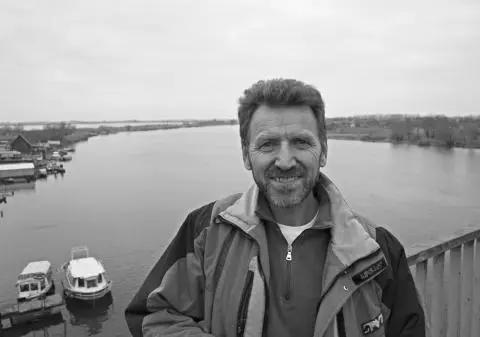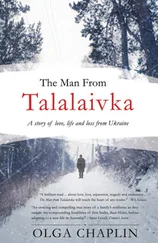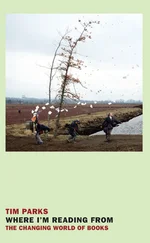In 1994 irrigation from the liman was restricted but not before almost 30,000 hectares of soil had been destroyed or their productivity badly damaged. Wells started to fill with salty water and some 3,000 people had to leave the irrigated area. The water also began to destroy the local ecosystem. There were floods, and birds died. Now the liman , said Rusev, who trained as a biologist, is “a soup of pathogens.” Historically Odessa was afflicted by cholera, which Rusev said “is like plague. It just sleeps. The microbes are just waiting and cholera could come from Sasyk again.”
The next morning Iryna took me down the bumpy road on the western shore of Sasyk. We passed a defunct old Soviet brick factory, the earth pockmarked with craters where the clay was dug up. Iryna said that on paper the factory still exists as a going concern, despite the fact that money was provided to close and move it even before the end of the Soviet Union. Now she thought the director used the premises to do something for his own benefit. On the other side of the road there is a monument indicating that this was the beginning of Trajan’s Wall, an earthwork system or defensive line supposedly built by the Roman emperor. It is hard to see anything here, and whether Trajan or the Romans really had anything to do with the earthwork line is hotly disputed by academics. Next we came to Borisovska, a neat village lining a road leading to a decrepit collection of old buildings, some in a state of virtual collapse, by the shore of the liman. This used to be one of a group of sanatoria around Sasyk and one of the best-known in the Soviet Union. Part of the building is a bakery now. We walked down the muddy track to look at the scruffy rubbish-strewn shore and returned to buy freshly baked bread.
People used to come here, said Iryna, for the healing effects of the water and mud baths. After Sasyk was closed off, the once therapeutic mud was lost as it filled with polluting heavy metals coming from the Danube. “There was a TB sanatorium and ones for children and adults. They treated bones, heart disease and abdominal diseases and then the system was destroyed.” Now, said Iryna, locals suffer from these diseases which used to be cured here and which they were less prone to before by virtue of living close to the lake. Since the closure of Sasyk respiratory diseases and cancers have shot up around the liman .
A few kilometers away is the village of Glubokoye. At the edge of the village, down a muddy path, is a cemetery. It is a bleak and windswept place. The gravediggers were digging and most of the modern graves are, like everywhere else in Ukraine, wreathed with bright and colorful plastic flowers. The first Cossack settlers began to bury their dead here when they arrived in the eighteenth century. Then, as now, the cemetery overlooked Sasyk, but every generation since has buried its dead further from the water and closer to the village. When Sasyk was closed, however, the water level changed. Before the closure it was 20 centimeters lower than the sea. When it was closed and the water remained too salty, the engineers raised the level to 60 centimeters above sea level, causing floods and land erosion. Now land on which the cemetery is situated ends abruptly as an earthy cliff above the water, and this has gradually been falling away.
Valeriy, a man in his sixties, out for a walk, pointed down to one place where the earth was crumbling into the water and where there used to be a beach. In his childhood, he said, it was always packed and it was hard to find a place to put down your towel. Villagers made lots of money renting rooms to vacationers. Years ago, he continued, the cemetery stretched another 150 meters out toward Sasyk. Today the last graves before the cliff are from the 1880s. A century or so of graves, including all the old Cossack ones with their characteristic Cossack cross stone tombstones, have gone, lost to the village and to history.
Gingerly we followed a slippery mud path down to the shore. Behind us there was a crashing sound as a little slice of land literally slipped away. Under the cemetery they have tried to stop the erosion by trucking in rocks, but the earth is still falling away because of the wind. It is a bizarre sight. At the top of the cliff, bones and coffin planks protrude from the earth where they were buried. The wind wears away the soil and eventually the remains fall onto the shoreline below. Bits of tombstone lie in the mud along with the odd bones and pieces of skull.
It is logical to conclude that, as this great Soviet engineering experiment has failed, the simple answer is that it should be reversed. The sluices should be opened, the sea should be let back into Sasyk and nature should be allowed to reverse the effects of human interference. This is what Iryna, Ivan Rusev and others have campaigned about for years. Appeals have gone to the government, commissions have been created to examine the problem and politicians, said Iryna, “pretend to do something.” It is a story that could be repeated ten thousand times across Ukraine. Politicians promise they will resolve a problem and “people start believing ‘finally this guy will do what he has to do’ and after that he forgets.” In the end real decisions are not taken here in little Tatarbunary, but still, in and around town, there are too many who “are literally parasites on this ecosystem.” They have all been fighting hard and have hitherto had the connections to prevent change. There is no more irrigation from Sasyk, but there are defunct pumping stations and they employ people. In total about a hundred work for the Ministry of Ecology, looking after the dike, the pumps and the pipes. They are, she said, “pumping out budget money” in the form of pay, but more than that, over the years, they have been stealing and selling off pipes and machinery, some of which are still in good condition. Still, if Sasyk was opened again they would no longer have their “phantom jobs.” And worse: “The other criminal thing,” pointed out Iryna dryly, is that the local authorities benefit from this system because they collect tax from these salaries and thus they are “fed for doing nothing.”
The next reason Sasyk is not reopened is fishing. Before the closure Sasyk was a spawning ground for Black Sea fish, but there were also freshwater fish, which now are the only ones to survive, albeit in tough conditions. The water is brackish and afflicted by suffocating algal blooms. It is also contaminated with the heavy metals washed down the Danube from industry upstream and then trapped in here. The water is thus toxic and does not meet sanitary norms, so, said Iryna, neither she nor others who know how bad the situation is would eat Sasyk fish. Still, people are poor and some can make a little money by fishing. But they cannot just cast off or take their boat to the middle of the liman as their grandfathers would have done. Now a businessman owns the fishing rights here, secured thanks to his political connections. Locals must buy expensive permits, adding to their costs such as equipment and fuel. And woe betide anyone who dares to fish without a permit. “He has guards and they will punish you.” Or worse, she said matter-of-factly, you could risk getting killed. If the lake was opened again then people could fish freely once more, so obviously the well-connected businessman has lobbied hard to keep his fishing preserve.
What has happened at Sasyk over the years has happened in different ways everywhere in Ukraine. Imagine a big ship. If you make a very small hole in the hull, it will leak but not sink. But if you make enough holes, the ship will keel over and begin to slip below the waves. Sasyk is one hole.

Ivan Rusev, ecologist and activist, on the bridge over the Dniester to Bessarabia. Mayaki, December 2015.
There is another small hole at the little town of Mayaki. I stood with Ivan Rusev on the bridge over the Dniester and he pointed to a complex of luxury houses being built illegally in the national park just on the Bessarabian side of the river. Since the Maidan revolution, he said, illegal building had soared. The reason was that the new government had stopped building inspections in order to save money, and on the basis of its conclusion that the system was so rotten and corrupt there was no point in sending out inspectors just so they could be bribed some more. They were indeed corrupt, said Rusev, but now, with no inspections whatsoever, those building illegally “are more active than ever.”
Читать дальше













